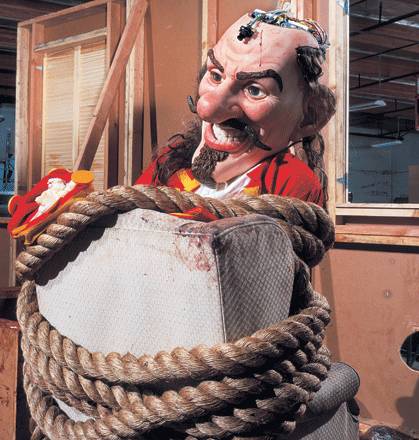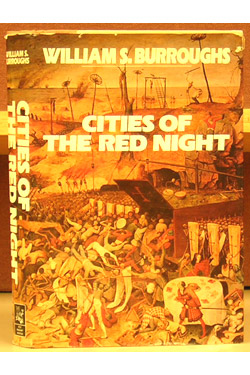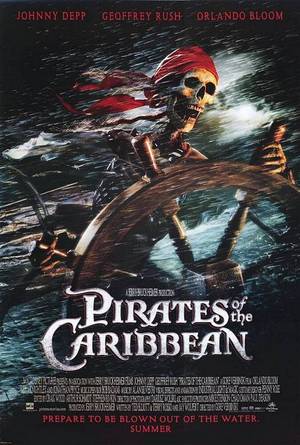January 05, 2006
Excremental Syrup: Paul McCarthy's USA
Fitting that Paul McCarthy’s La La Land: A Parody Paradise should have been showing in London in November and December, since the show is perfect for pantomime season.
It is literally excessive, in that there is too much to see and hear. The sculptures and outsize storyboard sketches on display in the Whitechapel gallery space turn out to be merely preparatory background for the infernal theme park-style installation, Caribbean Pirates, which McCarthy and his collaborators assembled in a crumbling warehouse just off Brick Lane.
There's an after-the-orgy/ post-traumatic mood in the chilly warehouse space, appropriately, since part of what the show examines is the reversibility of the orgiastic and the traumatic. Enter the space and you're confronted by ships, hulls, cabins and decks, including 'a splintery houseboat that might have drifted here from Cape Fear', each of them splattered with the detritus of atrocity and pleasure. As the Whitechapel material - some of which is retrospective and archival - establishes, Carribean Pirates is a kind of summation and recapitulation of McCarthy's signature obsessions. All of McCarthy's incarnations - Vienna Aktionist-inspired performance artist; painter of obscene doodles; sculptor of penile and scrotal grotesqueries - find expression in the show. The second-rate continually re-invent themselves; the great can only repeat themselves, differently, and McCarthy's work has all the compulsive repetitiveness of a trauma victim. The trauma his work registers is at one level the same one hidden and revealed in the sickly sweet Love and Napalm day-glo goo-goo dream-nightmare of Amerikan popular culture, a repellent-fascinating collage chopped together from pantomime, penises and porn.
McCarthy and his supporting crew of technicians and actors filmed a month's worth of now nauseating, now queasily hilarious performances, in which leering rubber-penile-nosed pirates re-enacted scenes of plunder from history and myth. The resulting films were then projected, in a vertiginous, quasi-haphazard manner, onto the walls of the warehouse, their time-sequences delirially cut and part-reserved, their soundtracks clashing; words are all but indistinguishable, drowned out by screeches and yelps of ecstasy, terror and pain issuing from the throats of those who might be the damned or the saved, or both. Bosch meets Bosch as limbs are brutally severed with screaming power tools. It is impossible to totalize or adequately narrativize the experience of walking through the space. The show, a reliquary of fragments, an assemblage of part objects, repudiates wholeness and the wholesome.

The buccanner bacchanalia la-la-land is less a Mutiny in Heaven than a Mutiny INTO heaven, a freebooters' taboo-breaching gatecrashing of Eden taking the form of a total refusal of the reality principle, an attempted recovery of the Imaginary, uncoded, radically innocent infant body. The storyboard sketches on display at the Whitechapel obsessively repeat variations of the phrase, 'cut the penis', indicating that the cost of entry into La La Land is the removal of the male organ. Yet the penises that erupt everywhere from the faces of the pirates are an embodiment of the inevitable frustration that awaits any attempt to regain a Paradise that can only ever be experienced as lost.
The transgressive drive to overcome the coding of the body was evident in McCarthy's early work in which he literally wallowed in such bodily excreta as saliva and shit. Films of those performances confront the viewer with their own internal censor, the involuntary and autonomic disgust reflexes at work in the skin and the gut which are the superego in person. The performances seem to be no less than attempts to reverse primary socialization, where the body is divided from the outside and then internally zoned into clean and unclean areas. The treatment of shit – what was once inside the body now abjected into an object of disgust located outside the body – is of course especially crucial in this process , so much so that Lacan famously claimed that human beings differentiated themselves from animals only at the point when they had a problem dealing with their own excrement.
In Caribbean Pirates, blood and shit become ketchup and syrup, a reverse trans-substantiation, an act of debasing sacralization, in which the vital fluids of Amerika's obscene-obese body-politic are desublimated from their advertising-generated Ideal into filthy physicality. Bodies are drenched in Hershey and Heinz; tin after tin of chocolate syrup is poured into ravenous mouths through plastic funnels which act as artificial, externalized sphincters. This vision of excremental syrup as a kind of sickly-sweetened diarrhea, a redeeming delirial elixir that passes through the body unchanged, that can be re-consumed even as it is expelled, has much to tell us about the fantasmatic economy that underlies America's financial economy.
Carribean Pirates is McCarthy's take on the Disneyworld ride, Pirates of the Carribean, the inspiration for the recent Johnny Depp film of the same name. The obvious question it prompts - who are the real carribean pirates? - has an equally obvious answer. How can they not be the agents of the Outlaw Superpower founded on slave-trading and plunder?
McCarthy's obsession with pirates can be seen as part of a general exploration of the concept of the Outlaw, so intrinsic to American mythology. (Some of his other work has dealt with the theme of the West.) The ineluctable conclusion to which Caribbean Pirates tends - that it is not the Law but the Outlaw that is tyrannical and terrorising - contradicts the implicit transgressive-utopianism of McCarthy's early performances. Unlike Burroughs, an obvious comparison, McCarthy seems to see the pirate not as a Utopian outsider, but as the Real face of mainstream American culture.

What McCarthy does have in common with Burroughs an awareness of the inherent theatricality of Sadism. In Burroughs’ novels, cruelty never occurs without stage-sets, costumes and mummery. To be humiliated is always to be ritually humiliated, as we can scarcely fail to be aware in the era of Abu Ghraib; and it’s impossible to walk through the seasick-scapes of La-La-Land without being reminded of Abu Ghraib. Simultaneously, however, we must recall that Abu Ghraib was already, in itself, a deranged piece of performance art. 'The very positions and costumes of the prisoners suggest a theatrical staging, a kind of tableau vivant, which brings to mind American performance art, “theatre of cruelty,” the photos of Mapplethorpe or the unnerving scenes in David Lynch’s films.'
This might be 'the obscene underside of American culture' but it is very far from being ‘the obscene underside of the Law’, since in a culture in which Law has been replaced by laissez-faire hedonic liberalism, Law and ritual survive only in their parodied-obscene forms. The ritual that has been disavowed at the level of the official culture, erupts at the level of the political unconscious.
Posted by mark at January 5, 2006 12:49 AM | TrackBack